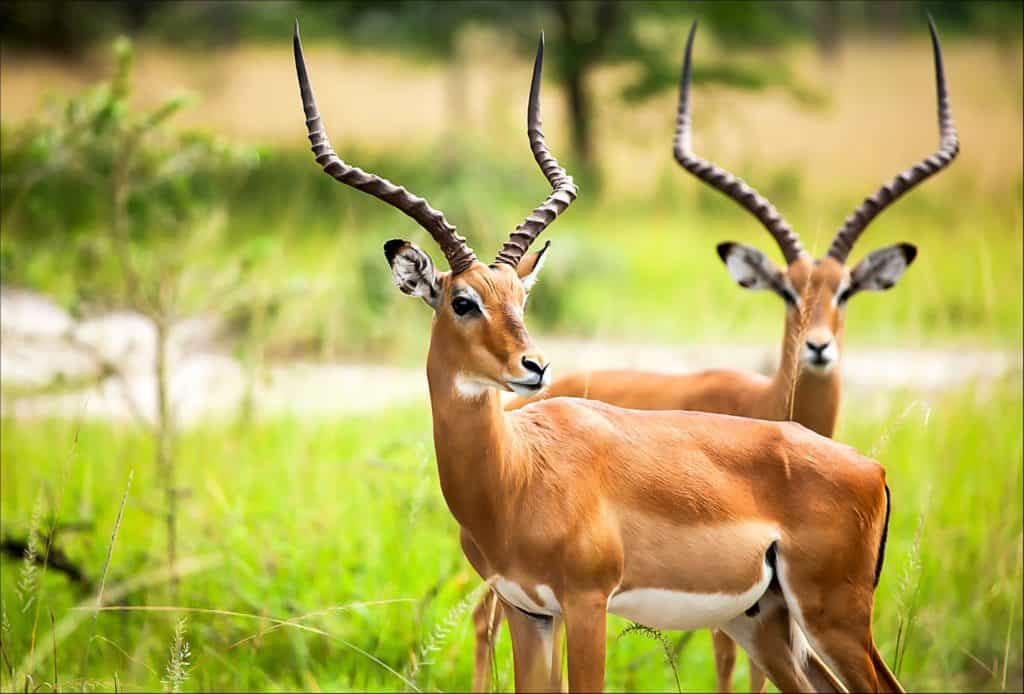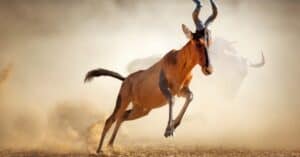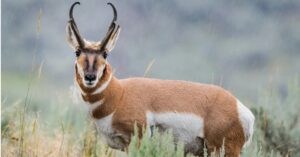“Antelope” is a broad term used to describe a few species of ruminant that live in Africa and Eurasia. While we often think of antelope as deer, they are not a part of the deer family. Instead, they are closely related to buffalo and bison as cloven-hoofed ruminants (a fancy way to say “two-toed animals with more than one stomach“). Let’s look at these interesting animals and learn what do antelopes eat?
What do antelopes eat?

Antelope are herbivores that eat leaves from trees and bushes, grasses, plants, weeds, and flowers.
©Lillac/Shutterstock.com
Antelopes eat tree shoots, leaves, plants, grasses, and flowers.
As herbivores, antelope stick to vegetation as their primary food source. When it comes to the specific types of plants that antelope eat, knowing the location, species, and habitat is essential. There are 91 antelope species, and most of them are from Africa. With such a diverse roster, speaking generally is usually best when referring to their diet.
Depending on the time of year, antelope will pick the most nutritious plants they can find. The two places that antelope primarily feed are on bushes and small trees. Leaves are typically their go-to, but they will switch to grasses without minding too much. Antelope are most active during the daytime (diurnal) but stick to shade during the hottest part of the day.
For many antelope species, feeding on leaves provides their primary water source. When the vegetation they consume has dew or a high level of water, antelope can supplement their internal water supplies. Since they are in arid environments, this adaptation is highly advantageous.
Specialized antelope diets

Antelopes get 90% of their nutrition from leaves.
©iStock.com/cowboy5437
Not all antelope eat the same things. Since there are so many species, let’s take a quick look at a few species of antelope that don’t just eat leaves and grasses and instead, eat something a little more interesting.
Addax (a species of antelope) follows the rain to eat. In its native habitat of the Sahara Desert, finding food can be tough. When it rains in the desert, new plant growth can sprout almost immediately. Following the rains allows addax to feast on these new sprouts as soon as they appear. This adaptation allows them to survive in one of the harshest climates in the world.
Thomson’s gazelle’s take a secondary approach to grazing. Instead of eating grasses directly, they follow behind larger herd animals to get the leftovers. While this may seem like a bad strategy, it’s actually a way to get the tastiest morsels. When gnu and zebra comb through an area, they mostly focus on the tough top layer of grass, leaving the tender shoots behind. When the gazelle’s come through, they get access to the tender shoots that were previously hidden behind the toughest grasses.
Duiker may have the most interesting diet of all the antelope species. Part of a duiker’s diet includes following flocks of birds and monkey troops to pick up discarded fruits that they are getting from trees. Since the duiker can’t reach the fruits, they let another animal do the hard work for them. Additionally, some species of duiker have been known to kill and eat insects and small mammals, changing their designation from herbivore to omnivore.
Finally, Royal antelope go into the woods at night, searching on the forest floor for their favorite foods: leaves, fruits, and mushrooms. Royal antelope are the smallest species of antelopes, while the largest antelopes in the world (giant elands) can weigh more than a ton!
A complete list of what antelopes eat
Here is a complete list of the common foods that antelope eat:
- grasses
- grass shoots
- leaves
- tender roots
- tubers
- shrubs
- fruits
- mushrooms
- insects
For the common antelope, tree leaves make up 90% of its diet.
How do antelope digest their food?

©siete_vidas/Shutterstock.com
While antelope may look like deer, they are actually more closely related to cattle, buffalo, and bison. Part of the antelope digestive system includes a rumen, a specialized organ designed to process tough, fibrous plant material.
For antelope eating tough grasses and leaves, their survival is dependent on their ability to break down the plants. The first step of the process is a quick chew that is then mixed with saliva. When an antelope chews, it mixes the plant material with saliva to allow enzymatic processes to begin. Then, they swallow the material and send it towards their rumen. The rumen squeezes the material and starts fermenting it to further break it down. As the food is broken down by the microbes, it is known as cud. The animal will then chew its own cud, further helping in the process.
After the cud has been chewed, the remaining mixture is sent back to a separate chamber where the nutrients are finally absorbed. Rumemints (animals with a rumen) are essential for any ecosystem because they can convert large swaths of inedible calories (grasses) into meat for other animals.
What eats antelope?
Antelope are essential to the ecosystems they live in. They are not apex predators and, therefore, provide an important food source to many other creatures on the savannah. Lions, leopards, hyenas, wild dogs, cheetahs, pythons, and a host of other animals all eat antelope as a primary food source.
Without ruminants, the mass amounts of trapped energy in the grasses would remain untapped. Large grazing animals act as “calorie creators” and turn grass into meat and energy for others. At the base of the food chain are the grasses, but one of the other supporting ecological structures are grazers like the antelope.
Additionally, humans play a role in the predation of antelope. Aside from hunting (a common method of acquiring antelope meat), some cultures have managed to mildly domesticate certain species. Elands are one example. Eland are currently kept by certain people groups in Zimbabwe. These domesticated elands are a source of meat, milk, and hides for the locals.
The photo featured at the top of this post is © Benas Bakevicius/Shutterstock.com
Thank you for reading! Have some feedback for us? Contact the AZ Animals editorial team.






